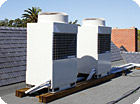
One of the 32 wall-mounted indoor units in the second- and third-floor dormitory rooms at the USC Kappa Kappa Gamma House, University of Southern California, Los Angeles.
The problems with the system had been going on for some time. However, major changes didn’t happen until after there was a catastrophic breakdown.
In November 2005, the first floor was completely flooded due to the failure of a hydronic system for the second- and third-floor dorm rooms. According to mechanical contractor Sirius Mechanical, Moreno Valley, Calif., the boiler’s improper design, and not having the right valving and expansion, led to a massive flood that affected both the first floor and basement.
“With their two-pipe system, they were having to shut down their chiller and boiler manually during system changeovers,” said Sirius sales manager Randy Scholnick.
“With all the stops and starts over time, the system failed. On their six-year-old chiller they’d already had two compressor replacements. There were no three-way valves in the system.
“I felt bad for these folks,” said Scholnick. “The sorority house board said they had spent half a million on service calls in the past 10 years.”
AFTER THE FLOOD
The original repair/replacement plan was based largely on the existing system. In April 2006, bids went out to local HVAC contractors to replace the building’s antiquated system with new cooling and heating systems.In addition to the top two dorm room floors (32 rooms were run off of a 25-ton chiller and a boiler), there was the first-floor dining room, kitchen (serviced by a 10-ton gas/electric packaged unit), a 2-ton cooling-only heat pump for the media room, and two 3-ton fan coils tied to two 2.5-ton heat pumps for the basement and the rest of the first floor. Sirius Mechanical’s winning bid included cleaning up the hydronics system for the second and third floors, and repairing the paint and drywall.
“We were a little nervous about that job,” said Scholnick. “It was a 20,000-square-foot facility made up of five fully functioning heating-cooling systems. The biggest concerns for us were the second and third floors, a total of 32 rooms. The flooding was a whole other issue.”
The plan originally included keeping the chiller in place, turning it into a four-pipe design, replacing the fan coils (which dated back to the 1960s), and tuning up the system. “We were going to revamp the boiler system and run a dedicated supply-return system in copy,” said Scholnick.

This wall-mount indoor unit provides heating or cooling for the computer/study room, of which there are two in the Kappa Kappa Gamma female fraternity house. Both dormitory floors have a dedicated computer/study room.
TIMING IS EVERYTHING
“The biggest challenge with schools is the timing factor,” Scholnick said. “If it’s a retrofit, we have a very limited window to operate with. You really only have the summer months, and usually we’re talking three months. There are also pressures because usually the college is doing other remodeling, and HVAC is just a part of that. It’s very difficult to do retrofits when school is in session.”A series of delays prevented the Kappa Kappa Gamma project from starting on time. Scholnick was told that Sirius would get the job on May 20, 2006, when the residents left for the summer. USC was going to loan the KKG House all of the renovation funds, and work was to begin the third week in May.
On May 15, however, the student board was told that the loan was on hold and they would have to wait a year. “Fortunately, a local bank stepped in and rewrote the loan. With funding in place, we executed a formal contract on June 16 and started the project. This delay put an enormous strain on all of us to complete the work before the students were to move in two months later,” Scholnick said.
During summer 2006, however, fan coils were in high demand. Sirius’ distributor said it couldn’t get the equipment until Aug. 15 - the same day the Kappas were scheduled to return for the 2006-07 school year.
If the residents couldn’t move in on time, “I don’t know what they were going to do,” Scholnick said. “They would lose a tremendous amount of money. To this day I have no idea what they were going to do.”

The two outdoor units are hidden out of sight on the roof of the USC Kappa Kappa Gamma House, Los Angeles, Calif. The ductless system replaced a two-pipe chiller-boiler-fan coil system.
WHAT NOW?
Scholnick called Steve Braley of U.S. Airconditioning Distributors, Riverside, Calif. Braley contacted Bobby Hahn, president of Pacific Systems Group, Torrance, Calif., and they held an emergency meeting with the KKG executive committee at the House on July 20 to discuss alternatives.They discussed a ductless solution. The City Multi® R2-Series variable refrigerant flow zoning system, from Mitsubishi, has the ability for each system to simultaneously cool and heat. The board decided to make the switch given the circumstances and tight deadlines. Plus, they trusted the contractor and understood the explanation of how the system would work.
When the go-ahead was finally given, Sirius had 20 days to complete the entire installation before the student board moved back into the house, and 29 days until all 83 residents were scheduled to follow.
Over the next three weeks, the Sirius crew replaced an aging 25-ton water chiller system and 32 hydronic fan coils with two 9-ton heat pumps, a centralized controller, two branch circuit (BC) controllers, and 32 8,000-Btuh wall-mounted indoor units.
FAST BUT GOOD
“When we popped the old fan coils out, we had a natural opening for the City-Multi wall mounts. There was good access for drain lines and refrigerant lines,” Scholnick saidThe new system can provide simultaneous heating and cooling without causing system imbalances that often result from thermostat wars. “We used a 16-branch circuit controller for each floor (15 dorm rooms, one computer/study room per floor) centrally located in a hallway. From the BC controller you run two 9-ton, 200,000-Btu heat pumps through the existing chase.”
Scholnick described the controller as “a box full of solenoid valves that open and close.” The system offers individual comfort for each of the 32 dorms, but also put overall HVAC management into the hands of the house director through a centralized controller.
The Sirius crew then replaced a 2-ton a/c system with a Mr. Slim® 2-ton, inverter-driven heat pump for the media room.
FINGERS CROSSED
“Because of the tight deadlines, we reversed the normal installation process and put up the drywall prior to performing the final installation of the indoor units,” Scholnick said. Sirius Mechanical quickly removed and disposed of all hydronic fan coils throughout the building. Then they patched and painted all of the places where air grilles, fan coils, and thermostats had been.“By Aug. 15, the job was 100 percent complete - on time and on budget,” Scholnick said. As the contractor’s employees were leaving, the residents were coming.
The system ran as designed throughout the 2006-07 school year, at full capacity on both floors.
“The only maintenance required is filter maintenance,” Scholnick said. “Each fan coil has a slide-out filter that needs to be brushed out every 60 days, and 17 condensate pumps need to be checked periodically. Probably every two years we’ll come in and check the charge for the heat pump.”
“Fantastic! I have never seen anything like it,” said Donna Lou Guay, the women’s fraternity’s USC house director. “The system works beautifully.”
The contractor is doing more and more campus work; probably 25 percent of the company’s work right now is in schools and universities, Scholnick said. “As a result of the Kappa Kappa Gamma job, we were hired to do an IT server room for Clairmont College, and we’re doing the Harvey Mudd college West Residence Hall.”
The IT server application again was “a very tight situation because we have new server equipment coming in and the heat gain produced from that. Their existing system couldn’t keep up with it.” When installing a Mitsubishi Y Series with five one-way ceiling cassettes (cooling only), “we had to work around finals. Students in the library didn’t want to be interrupted by Sawzalls. There’s practically no after-hours availability for an IT lab. We got most of it done during the winter break.”
Sidebar: Installation
Sirius Mechanical is performing HVAC installations for the Mitsubishi Training Center in Irvine, Calif. The 5,000-square-foot building contains a 2,000-square-foot training room, where the contractor is installing a variety of CM and Mr. Slim M and P Series ductless systems, just for the purpose of training. “These are accessible and serviceable, installed below the T-bar ceiling,” said Sirius sales manager Randy Scholnick.Publication Date:08/06/2007

Report Abusive Comment